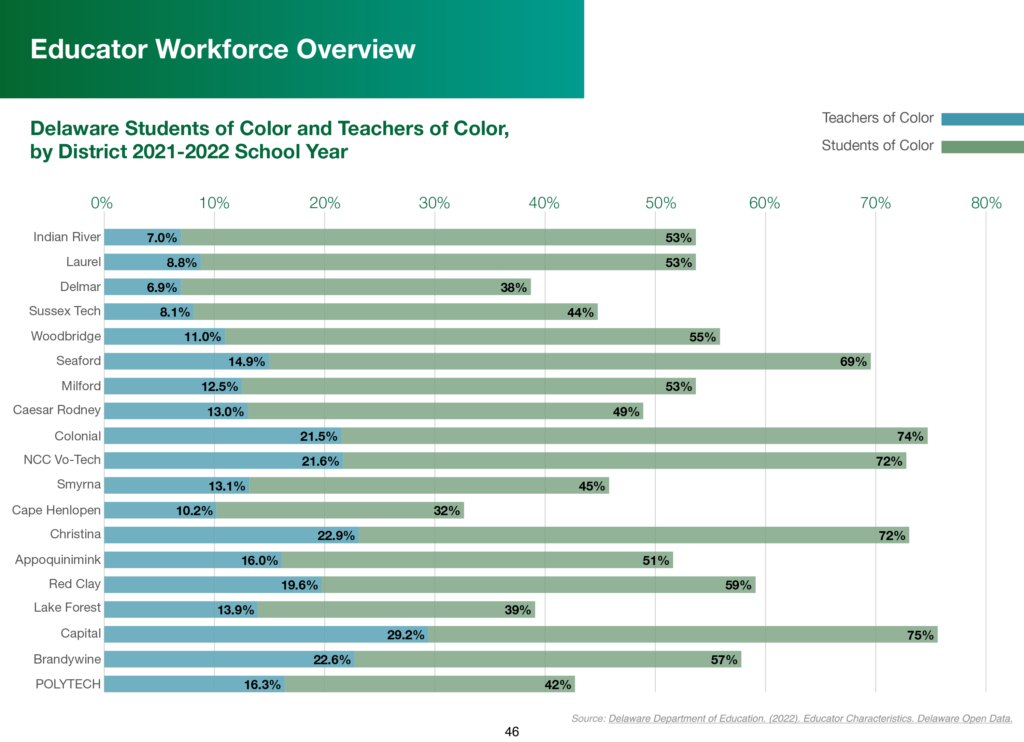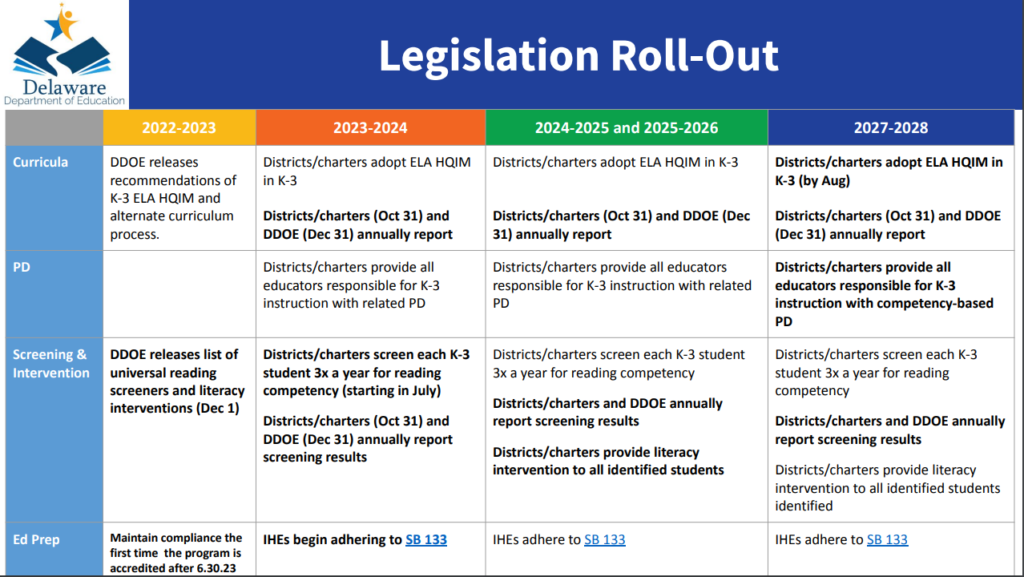UPDATED: March 20, 2024. Click here for an official announcement from Gov. John Carney and the Delaware Department of Health and Social Services.
-Delaware has committed to implementing some of the new federal regulations on child care—including reduced co-pays for families and increasing absent days. The state has not yet committed to when it will comply with the requirement to compensate providers based on enrollment vs. attendance.
-The changes will address some family needs in Delaware, but not all.
-The state has committed to increasing rates to pay providers based on the new market rate study anticipated next month.
-Big opportunities remain for Delaware, including increasing eligibility for state assistance and increased child care investments.

When it comes to funding Purchase of Care, the state subsidy that helps families cover child care tuition, about 30 percent comes from federal dollars funneled through the U.S. Department of Health and Human Services, Administration for Children and Families, Office of Child Care.
As with most federal dollars, there are rules and regulations attached to how they are spent. Earlier this month, the office released its new set of rules to govern the Child Care Development Fund (CCDF).
The new rules go into effect on April 30, 2024.* Delaware and other states must submit plans later this summer for how they will retool funding and policies for Federal Fiscal Year 2025-27, which begins October 1, 2024. (These summaries outline what states must do and what they may do with federal funds, including several policies underway in Delaware.)
The new rules are designed to improve child care access, affordability, and stability. What do they require and what will they mean for Delaware families?
Required Policy Changes—and Additional Opportunities for Delaware
- Improve family affordability by limiting co-payments. This rule requires states to establish co-payment policies that ensure families receiving CCDF subsidy pay no more than seven percent of their family income for child care regardless of family size.
Eliminate co-payments for the families in greatest need. The rule allows states increased flexibility to waive co-payments for additional families—families with income at or below 150 percent of the federal poverty line, families with a child with a disability, children who are in foster care/kinship care, families experiencing homelessness, and families with children enrolled in Head Start or Early Head Start.
Currently, Delaware’s co-pay schedule goes up to nine percent and exempts only those below 70 percent of the poverty line.
UPDATE: At the Delaware Early Childhood Council meeting March 19, the Department of Health and Social Services committed to implementing both the required and allowable policies as of June 2024. These changes impact about 75 percent (8,000 of the 12,000) children and families served by Purchase of Care; most families served are below 150 percent of the Federal Poverty Level and will have no copayment.
Additional Opportunity: Delaware could get permission from U.S. Department of Health and Human Services and use state dollars to eliminate copayments altogether. For example, families in Delaware earning up to 200 percent of the Federal Poverty Level (FPL) are eligible for food benefits (SNAP), however the state requires them to pay for child care.
- Provide stability to child care programs, so they can plan their budgets and hire staff based on enrollment.
- A. Grants and Contracts. This rule requires states to use some grants and contracts for slots for children in underserved geographic areas, infants and toddlers, and children with disabilities. This is similar to how state-funded pre-K (the Early Childhood Assistance Program, or ECAP) works, with an annual contract to cover a slot for a child—similar to the approach used in public K-12 education.
Additional Opportunity: This rule encourages states to consider other populations that may benefit from grants or contracts, including care for children during nontraditional hours.
- B. Prospective Payments. This rule requires states to pay child care providers serving CCDF families prior to the delivery of services or at the beginning of the delivery of services to align with private-pay practices. This helps providers cover costs for the month, including staff.
- C. Payments Based on Enrollment. This rule requires states to pay subsidy based on authorized enrollment, not attendance. This helps providers cover fixed costs including staff, whether children attend or not—and it helps stabilize their finances when children are sick or families are away. Thirty-six states already pay based on enrollment.
UPDATE: Waivers and plans to adopt these policies in the next two years will be submitted as part of Delaware’s federal plan by July 1, 2024. As of June 2024, the state committed to paying for 10 absent days per month per child. The current limit of five per month has created instability for families and providers, especially when children are sick and staff are hired to full-time commitments.
Many of the updated rules are underway in Delaware, such as consumer education, payment of subsidy above the private pay rate, presumptive eligibility, and eligibility simplification.
Do these rules address the needs of Delaware’s families? Yes—in part. What else do families and providers need?
- Expanded eligibility. Delaware’s subsidy eligibility will be raised to 200 percent FPL if the Governor’s Recommended Budget is passed; however, all our neighboring states and most other states set their eligibility limits above 250 percent, with some much higher. After minimum wage and other increases, many families are no longer eligible but cannot afford care.

Delaware is currently serving about 30 percent fewer children on Purchase of Care than in years past—likely in part because some families now “make too much” when eligibility has not kept up with families’ realities.
- Increased rates. The state rate per child must be raised to cover not just basic costs to operate a licensed child care facility in the state but also increased costs of staff and increased needs of children.
The state bases its rates on the “market rate,” a seriously flawed mechanism based on a broken market. The General Assembly directed DHSS to support Purchase of Care based on 100 percent of the 75th percentile of the 2021 market rate—and we will have a new rate available in April 2024.
The study, which is conducted every three years, regularly notes a nine- to 10-percent increase in providers’ operating costs. Recent increases to minimum wage and inflation continue to drive costs higher.
UPDATE: DHSS also committed at the March meeting to “fully fund” the updated rates in the 2024 market rate study (meeting 100 percent of the 75th percentile when new rates are released). We anticipate rates increasing up to 10 percent, likely beginning in July with the new fiscal year. No rate increase had been discussed until the announcement this week.
The General Assembly also directed DHSS to move toward a cost of care methodology—this study showed the state was paying far below the cost of basic licensed care in Delaware and far below the cost of quality. An updated study is anticipated in May.
- Workforce benefits. The child care workforce generally makes minimum wage, with no benefits. Many of them are on public assistance, but for those who are not, some states have provided subsidized child care or health benefits to child care workers earning up to 400 percent FPL. As soon as many educators get their degrees, they leave child care for school district jobs that pay twice as much for a school year with benefits. In order to attract and retain workers, child care has to be able to offer greater compensation and benefits.
UDPATE: DHSS committed to a “one time workforce enhancement,” likely similar to bonuses awarded in previous years to early care and education employees who have served for a minimum amount of time in the field. The move provides short-term compensation support.
These new investments are being funded by existing resources; DHSS released a report in March that noted over $40 million of the $122 million Purchase of Care budget was anticipated to go unspent in FY24. The hope is that some of the FY24 funds can be spent this year, and commitments were made that the ongoing policies would continue going into FY25 and beyond.
Reactions from the Field
Child care program leaders and advocates at the DECC meeting responded to this news with enthusiasm, thanking the Carney Administration and looking forward to even more progress in the future.
At the same meeting, providers were excited to hear that the Department of Education would award quality funding (formerly tiered reimbursement connected to a STARs quality rating) at a level of at least as much as programs received in the past, based on the number POC children served, and provided annually through a streamlined process. The initial plan is for awards to be as high as $180,000 depending on the size of program and percentage of POC children served.
The strong sense from members of the Delaware Early Childhood Council and participants was that the Carney Administration was listening and investing funds in ways that will support programs and families.
What’s next and what can I do?
- To provide input on Delaware’s next steps, attend public CCDF feedback meetings, including Delaware Early Childhood Council meetings March 19 and May 21 (sign up for the newsletter here).
- Reach out to your legislators to tell them to invest more in early care and education bit.ly/FY25ChildCareAsk.
- Tell candidates for office this issue is a priority for you and ask what they will do to expand access and affordability.
* States that are not in compliance with the provisions of the final rule by April 30, 2024 may request a temporary waiver for an extension of up to two years to ensure there is enough time to execute the steps to comply with regulations.




